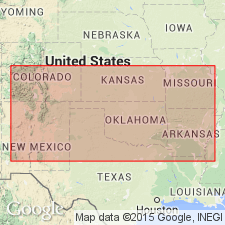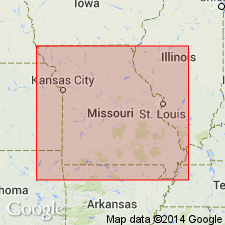
- Usage in publication:
-
- Skrainka diabase
- Modifications:
-
- First used
- Dominant lithology:
-
- Diabase
- AAPG geologic province:
-
- Midcontinent region
Summary:
First used. Shown on stratigraphic chart of Missouri. Overlies Iron Mountain porphyries; unconformably underlies Pilot Knob conglomerates. Described as a diabase. No thickness given. Placed within Francoisian Series of Late Algomic (Archeozoic) age.
Source: GNU records (USGS DDS-6; Denver GNULEX).

- Usage in publication:
-
- Skrainka diabase
- Modifications:
-
- Revised
- AAPG geologic province:
-
- Midcontinent region
Summary:
Skrainka diabase. A basic post-batholithic intrusive rock commonly found in irregular tabular sill-like masses and in small bosses, mainly in east-central part of St. Francois Mountains, southeastern Missouri. Intrudes granite rocks of Musco and Bevos groups and into the felsite rocks of Middlebrook and Van East groups. Consists of dark, bluish-gray diabase; has medium- to fine-grained diabasic texture with gray feldspar laths. Most known exposures are within granites; unit is believed to be a differentiate of granitic batholith. Exposures are few due to extreme chemical weathering; generally exposures consist of a series of isolated, rudely spheroidally, weathered, dark-gray boulders in roadcuts or along stream banks; boulders have characteristic knob and pit surface; rock is fresh below knobby surface and intensely to completely weathered above surface. Unconformably underlies Lamotte formation. Age is Precambrian.
Typically developed at Skrainka quarry, in sec. 3, T. 33 N., R. 6 E., Madison Co., MO.
Source: Modified from GNU records (USGS DDS-6; Denver GNULEX).
For more information, please contact Nancy Stamm, Geologic Names Committee Secretary.
Asterisk (*) indicates published by U.S. Geological Survey authors.
"No current usage" (†) implies that a name has been abandoned or has fallen into disuse. Former usage and, if known, replacement name given in parentheses ( ).
Slash (/) indicates name conflicts with nomenclatural guidelines (CSN, 1933; ACSN, 1961, 1970; NACSN, 1983, 2005, 2021). May be explained within brackets ([ ]).

